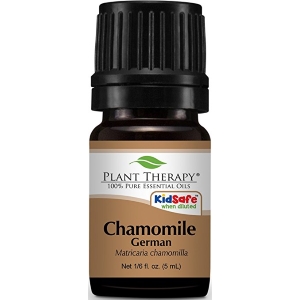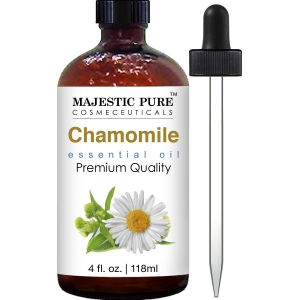The difference between German and Roman chamomile essential oils can be summed up in a nutshell. It’s all about the chemical makeup of the two oils. Though both German and Roman chamomile essential oils are often used interchangeably in treating an assortment of conditions, they are not the same and thus the purpose of this post. We believe in keeping our goddesses well informed.
Roman Chamomile and German Chamomile Essential oils similarities
They both come from plants, albeit different plants. Big duh there, huh? They both are steam distilled from the flowers to produce the essential oils. Both German and Roman chamomile oils have similar uses, but the chemistry is different. There, now that we’ve gotten that out of the way let’s move on.
General Information on German and Roman Chamomile Essential Oils
German Chamomile
Roman Chamomile
Matricaria recutita Synonyms: Chamomilla chamomilla, Chamomilla recutita, Matricaria chamomilla, and Matricaria suaveolens. Anthemis nobilis Synonyms: Chamaemelum nobile Grown in Europe, England, South America, and the US Grown in Europe, England, South America, and the US
Chemistry of German and Roman Chamomile Essential Oils
Though there are over 120 ingredients in chamomiles, the most bioactive ingredients are included in the table below.
German Chamomile
Roman Chamomile
Terpenoids a-bisabolol, a-bisabolol oxide A and B, chamazulene (gives the oil a blue color and is higher in concentration), sesquiterpenes Chamazulene (lower concentration than found in German chamomile), bisabolol Flavonoids apigenin, luteolin, quercetin apigenin, luteolin, quercetin Coumarins umbelliferone scopoletin-7-glucoside Spiroethers en-yn dicycloether Other anthemic acid, choline, tannin, polysaccharides angelic and tiglic acid esters, anthemic acid, choline, phenolic and fatty acids (Information on chemical constituents from: http://www.longwoodherbal.org/)
Uses of German and Roman Chamomile Essential Oils
I debated about how to put this part together for you. I could have used a use by chemical constituent or a general for each of these two oils. I decided to go with the latter approach because I thought it would be easier to differentiate between the two oils that way.
German Chamomile
Roman Chamomile
External Inflammation of the skin (including acne, eczema, psoriasis), mucous membranes and ano-genital area, bacterial skin diseases including those of the mouth and gums, and respiratory tract inflammation (inhaled) Inflammation of the skin (including acne, eczema, psoriasis), mucous membranes and ano-genital area, bacterial skin diseases including those of the mouth and gums, and respiratory tract inflammation (inhaled) Internal Cystitis, cold, flu, malaria, parasitic worms, gastrointestinal spasms, inflammatory diseases of the gastrointestinal tract, liver tonic Cystitis, cold, flu, malaria, parasitic worms, gastrointestinal spasms, inflammatory diseases of the gastrointestinal tract, liver tonic Contains more active ingredients which make it a more potent oil. Better anti-inflammatory due to higher concentration of Azulene Better as a calming agent and use for sore muscles
Precautions when using German and Roman Chamomile Essential Oils
Though both German and Roman chamomile essential oils are considered safe to use, there are a couple of precautionary notes. Like with any product whether you buy it or make it at home, test it to be sure you don’t have an allergy to it. Be particularly cautious if you are allergic to ragweed. Though there are no reported problems with using these oils internally during pregnancy, one study on pregnant mice caused the fetuses to reabsorb and babies to be born undersized. Until more is known, I recommend you not use these oils internally if you are pregnant or nursing.
Unless you know what you are doing, I strongly recommend taking these oils internally from commercially manufactured capsules you purchase. We just say no to our goddesses having problems because they’ve accidentally overdosed. However, using them on your skin, in a massage oil or diffuser should be just fine providing you aren’t allergic to them.
Conclusion
In a number of the studies done on both German and Roman chamomile, other oils were added. To me that invalidates any conclusion that it was the chamomile oil responsible for the results. I mention this for those of you out there that, like me, who research in depth the supposed benefits of any product that is put on the skin, inhaled or swallowed.
That said, there is sufficient research that makes the chamomile oils part of my permanent collection to have on hand. I like to use the German chamomile in my lotions, creams, and massage oils due to the higher concentration of chamazulene and en-yn dicycloether. I use it in a diffuser when I have a cold. At night I sometimes will drink a nice cup of Roman chamomile tea before bed to get a wonderfully restful night’s sleep. In addition to the recipes below, watch for future posts with more recipes that use both German and Roman chamomile.
Now go have fun and relax.
Recommended products:
Plant Therapy Chamomile German Essential Oil. 100% Pure, Undiluted, Therapeutic Grade. 5 mL (1/6 Ounce) Chamomile Essential Oil From Majestic Pure, 4 Fl. Oz – Premium Quality Roman Chamomile Oil
Chamomile Essential Oil From Majestic Pure, 4 Fl. Oz – Premium Quality Roman Chamomile Oil </p
</p




You are most welcome.
which would be better for eczema???
Though both have anti-inflammatory properties, German chamomile appears to be preferred for treating eczema and other skin conditions.
where can I buy german chamomile essential oil?
We purchase our essential oils from Ancient Healing Oils. We like the high quality of all their oils. They supply us with both German and Roman chamomile.